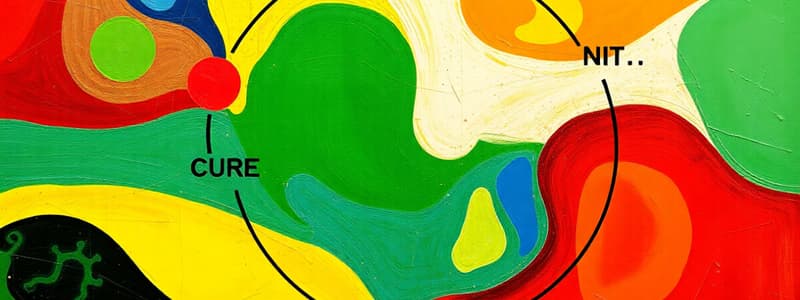Podcast
Questions and Answers
What is the primary purpose of the urea cycle?
What is the primary purpose of the urea cycle?
- To synthesize vitamins
- To produce energy
- To detoxify ammonia (correct)
- To conserve glucose
Ammonia is less toxic than the ammonium ion.
Ammonia is less toxic than the ammonium ion.
False (B)
What enzyme detoxifies peroxide generated during amino acid oxidation?
What enzyme detoxifies peroxide generated during amino acid oxidation?
Catalase
The glucose-alanine cycle helps prevent glucose from being used in muscle cells, where it would be broken down into _____ and ketone bodies.
The glucose-alanine cycle helps prevent glucose from being used in muscle cells, where it would be broken down into _____ and ketone bodies.
Which of the following statements about ammonia toxicity is true?
Which of the following statements about ammonia toxicity is true?
What does the enzyme glutaminase generate when it removes nitrogen?
What does the enzyme glutaminase generate when it removes nitrogen?
Match the following terms with their functions:
Match the following terms with their functions:
A complete block in any step of the urea cycle can lead to a compatible life.
A complete block in any step of the urea cycle can lead to a compatible life.
The concentration of the ammonium ion is _____ times higher than ammonia in physiological conditions.
The concentration of the ammonium ion is _____ times higher than ammonia in physiological conditions.
Which of the following correctly describes the role of the glucose-alanine cycle?
Which of the following correctly describes the role of the glucose-alanine cycle?
What is the primary function of Alpha Keto Glutarate in treating hyperammonemia?
What is the primary function of Alpha Keto Glutarate in treating hyperammonemia?
The urea cycle primarily occurs in the kidneys.
The urea cycle primarily occurs in the kidneys.
What condition is associated with the intolerance to protein ingestion?
What condition is associated with the intolerance to protein ingestion?
The first enzyme of the urea cycle is called _____ Transcarbamylase.
The first enzyme of the urea cycle is called _____ Transcarbamylase.
Which of the following statements is true about the urea cycle?
Which of the following statements is true about the urea cycle?
What is the major consequence of hyperammonemia on the nervous system?
What is the major consequence of hyperammonemia on the nervous system?
Match the urea cycle enzymes with their functions:
Match the urea cycle enzymes with their functions:
Alpha Keto Glutarate is used to treat hyperammonemia by detoxifying ammonia directly.
Alpha Keto Glutarate is used to treat hyperammonemia by detoxifying ammonia directly.
The urea cycle converts nitrogen from _____ into urea.
The urea cycle converts nitrogen from _____ into urea.
What dietary modification is recommended for patients with urea cycle defects?
What dietary modification is recommended for patients with urea cycle defects?
What is the role of N-Acetylglutamate in the urea cycle?
What is the role of N-Acetylglutamate in the urea cycle?
The urea cycle consists of only one enzyme.
The urea cycle consists of only one enzyme.
What is the product formed when arginine is processed in the urea cycle?
What is the product formed when arginine is processed in the urea cycle?
The rate-limiting enzyme in the urea cycle is ______.
The rate-limiting enzyme in the urea cycle is ______.
Match the enzymes with their corresponding substrates:
Match the enzymes with their corresponding substrates:
Which of the following compounds is NOT a precursor for urea?
Which of the following compounds is NOT a precursor for urea?
Hyperammonemia occurs due to a lack of nitrogen in the blood.
Hyperammonemia occurs due to a lack of nitrogen in the blood.
Name the final product of the urea cycle.
Name the final product of the urea cycle.
Citrulline is converted to argininosuccinate by the enzyme ______.
Citrulline is converted to argininosuccinate by the enzyme ______.
What is the first step of the urea cycle?
What is the first step of the urea cycle?
What is a key symptom of Ornithine transcarbamylase (OTC) deficiency?
What is a key symptom of Ornithine transcarbamylase (OTC) deficiency?
CPS 1 deficiency is characterized by elevated orotic acid levels.
CPS 1 deficiency is characterized by elevated orotic acid levels.
What is the primary diagnosis for OTC deficiency?
What is the primary diagnosis for OTC deficiency?
In cases of hyperammonemia, _____ levels are typically elevated.
In cases of hyperammonemia, _____ levels are typically elevated.
Match the enzyme deficiencies with their respective diagnoses:
Match the enzyme deficiencies with their respective diagnoses:
Which of the following is a major clinical sign of hyperammonemia?
Which of the following is a major clinical sign of hyperammonemia?
Both OTC and CPS 1 deficiencies result in lethargy as a symptom.
Both OTC and CPS 1 deficiencies result in lethargy as a symptom.
What is the typical ammonia level observed in hyperammonemia?
What is the typical ammonia level observed in hyperammonemia?
CPS 1 deficiency results in decreased _____ levels.
CPS 1 deficiency results in decreased _____ levels.
What can potentially result from untreated hyperammonemia?
What can potentially result from untreated hyperammonemia?
Flashcards are hidden until you start studying
Study Notes
Nitrogen Metabolism and the Urea Cycle
- Urine is acidic, trapping ammonia as the ammonium ion, which is less toxic than ammonia.
- Glutaminase removes nitrogen and produces glutamate and glutamine, acting as an intracellular nitrogen carrier.
- L amino acid oxidase requires FMN and generates peroxide.
- D amino acid oxidase uses FAD and generates peroxide.
- The glucose-alanine cycle (Cahill cycle) conserves glucose by converting alanine to pyruvate, which is then converted back to glucose in the liver.
- Catalase, found in peroxisomes, detoxifies peroxide produced by L and D amino acid oxidases.
- Ammonia with levels greater than 10 micrograms per liter is toxic to cells.
- Ammonium ion is less toxic, with a toxic level of around half a milligram.
- The urea cycle is essential for life, converting ammonia into urea for excretion.
- A complete block in any step of the urea cycle is incompatible with life.
- Urea cycle defects can lead to hyperammonemia, causing ammonia intoxication, protein intolerance, and mental and CNS deficiencies.
- Alpha-ketoglutarate is used to treat hyperammonemia by transaminating nitrogen to form glutamate.
- The urea cycle is split between the mitochondrion and cytosol.
- Carbonyl phosphate synthetase 1 (CPS 1) catalyzes the reaction of bicarbonate and ammonium ion to form carbonyl phosphate.
- Ornithine transcarbamylase catalyzes the reaction between ornithine and carbamyl phosphate to form citrulline.
- CPS 1 is the first enzyme in the urea cycle, while ornithine transcarbamylase is the second.
- Hyperammonemia is characterized by high ammonia levels in the blood, often caused by urea cycle enzyme deficiencies.
- N-acetylglutamate synthetase activates the urea cycle by generating N-acetylglutamate, which in turn activates CPS 1.
- Aspartate, free ammonium ion, and carbamyl phosphate are the precursors used for the urea cycle.
- The urea cycle consists of two enzymes: CPS 1 and ornithine transcarbamylase (OTC).
- CPS 1 is the rate-limiting enzyme, regulated by N-acetylglutamate.
- The urea cycle steps:
- Ammonium ion + Bicarbonate → Carbamyl phosphate (via CPS 1)
- Carbamyl phosphate → Citrulline (via OTC)
- Citrulline → Argininosuccinate (via Argininosuccinate Synthetase)
- Argininosuccinate → Arginine (via Argininosuccinate Lyase)
- Arginine → Urea (via Arginase)
- Urea → Ornithine (via Arginase)
- Hyperammonemia is diagnosed by elevated ammonia levels, decreased BUN levels, and increased blood glutamine levels.
- OTC deficiency symptoms include hyperammonemia, elevated carbamyl phosphate levels, and elevated orotic acid levels.
- OTC deficiency is diagnosed by the presence of orotic acid in urine.
- CPS 1 deficiency symptoms include hyperammonemia, decreased carbamyl phosphate levels, and decreased orotic acid levels.
- CPS 1 deficiency is diagnosed by the absence of orotic acid in urine.
- Clinical signs and symptoms of hyperammonemia include central edema, lethargy, convulsions, coma, and death.
- Ammonia can cross the blood-brain barrier, leading to central edema.
Summary Table
- OTC Deficiency: Symptoms include hyperammonemia, elevated carbamyl phosphate, elevated orotic acid. Diagnosis is Orotic Acid Urea.
- CPS 1 Deficiency: Symptoms include hyperammonemia, decreased carbamyl phosphate, decreased orotic acid. Diagnosis is No Orotic Acid Urea.
Studying That Suits You
Use AI to generate personalized quizzes and flashcards to suit your learning preferences.



